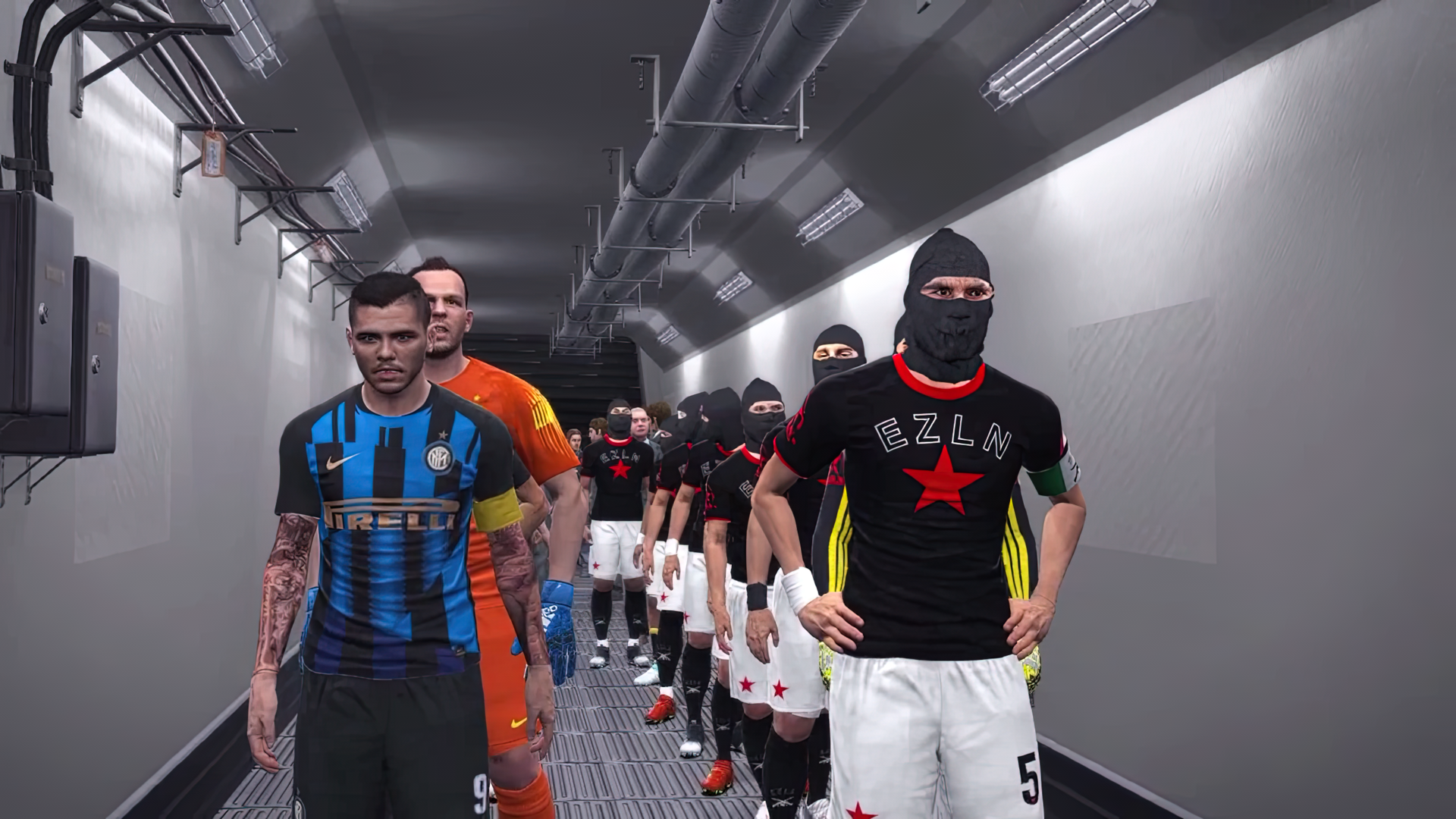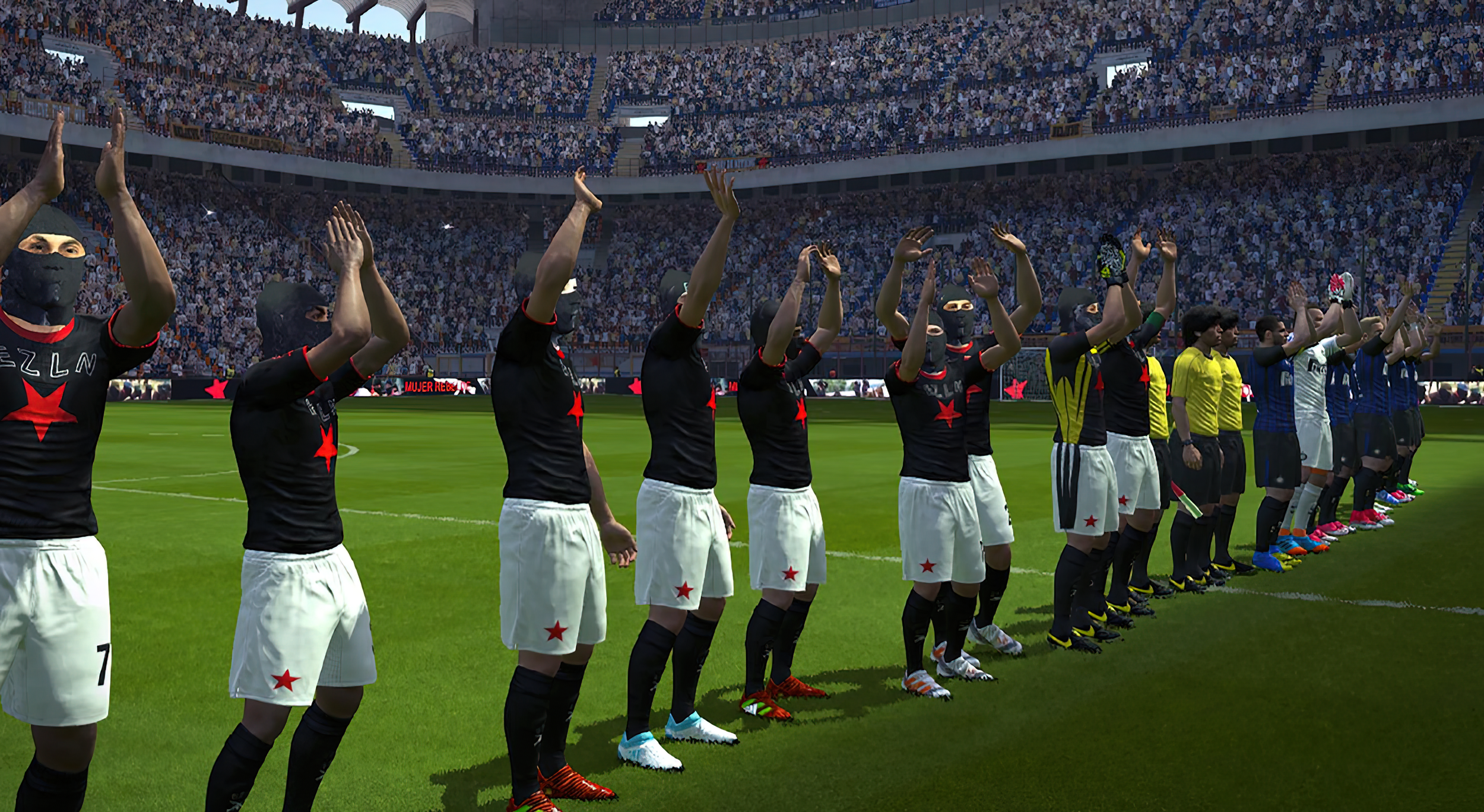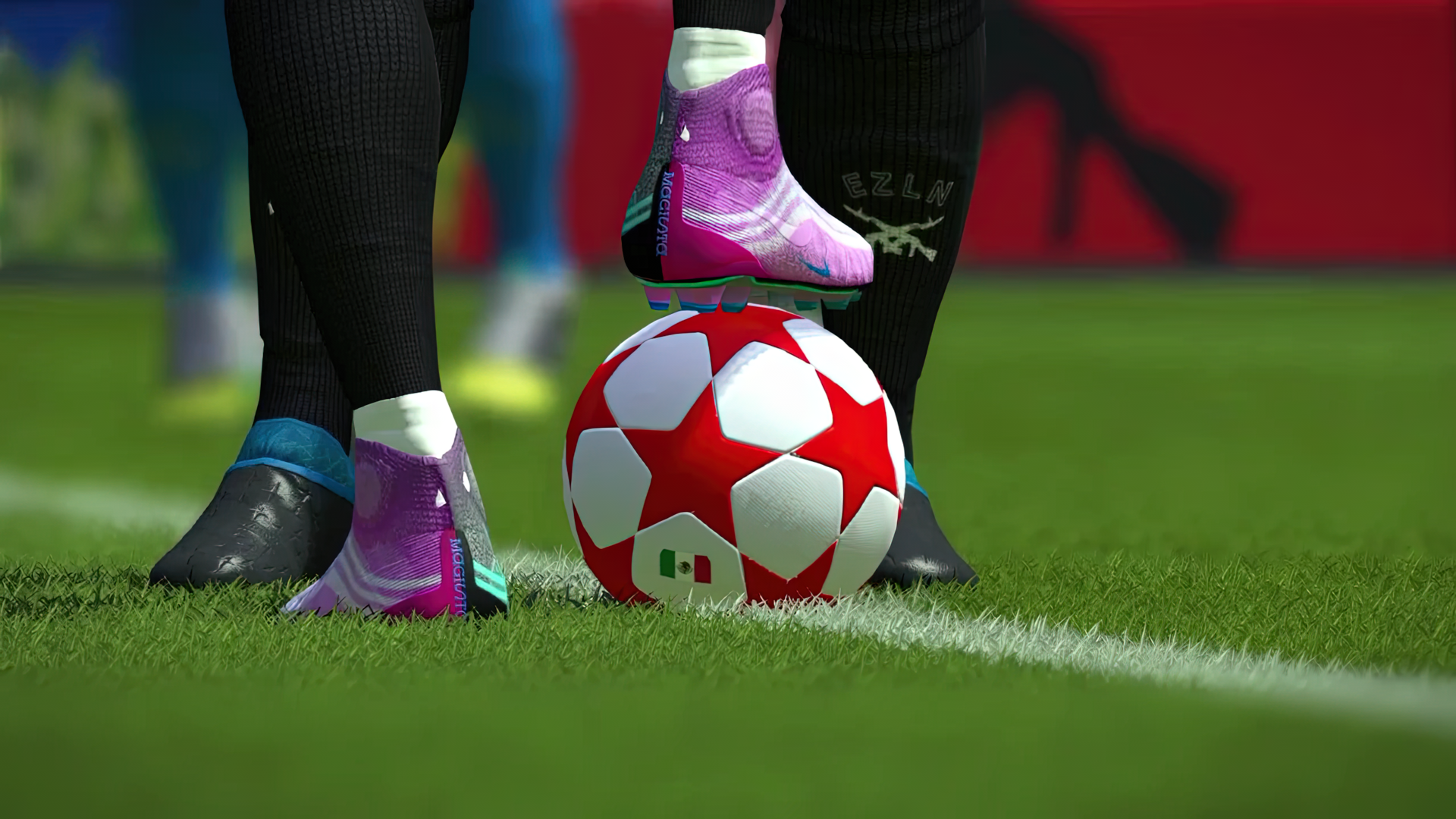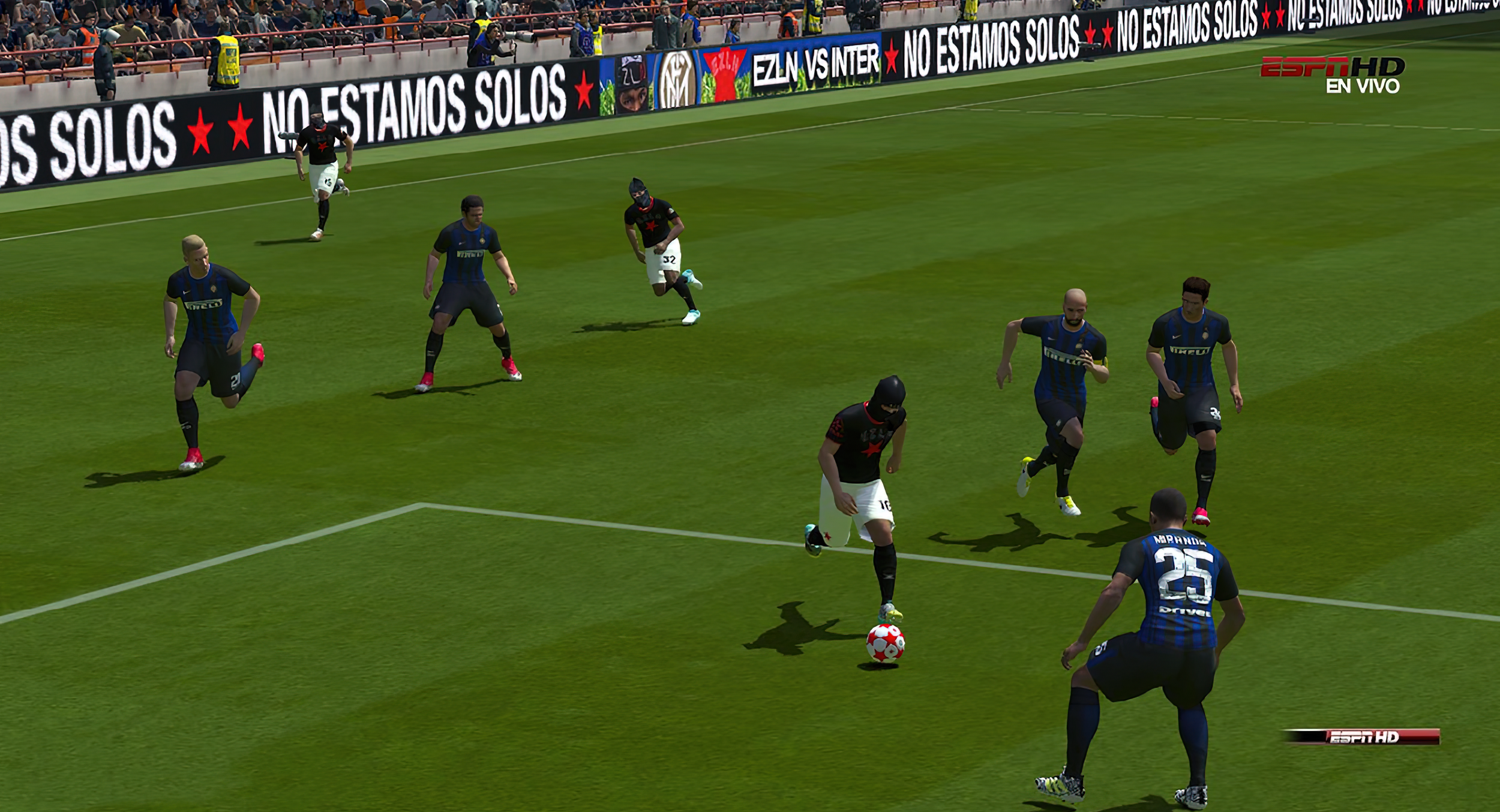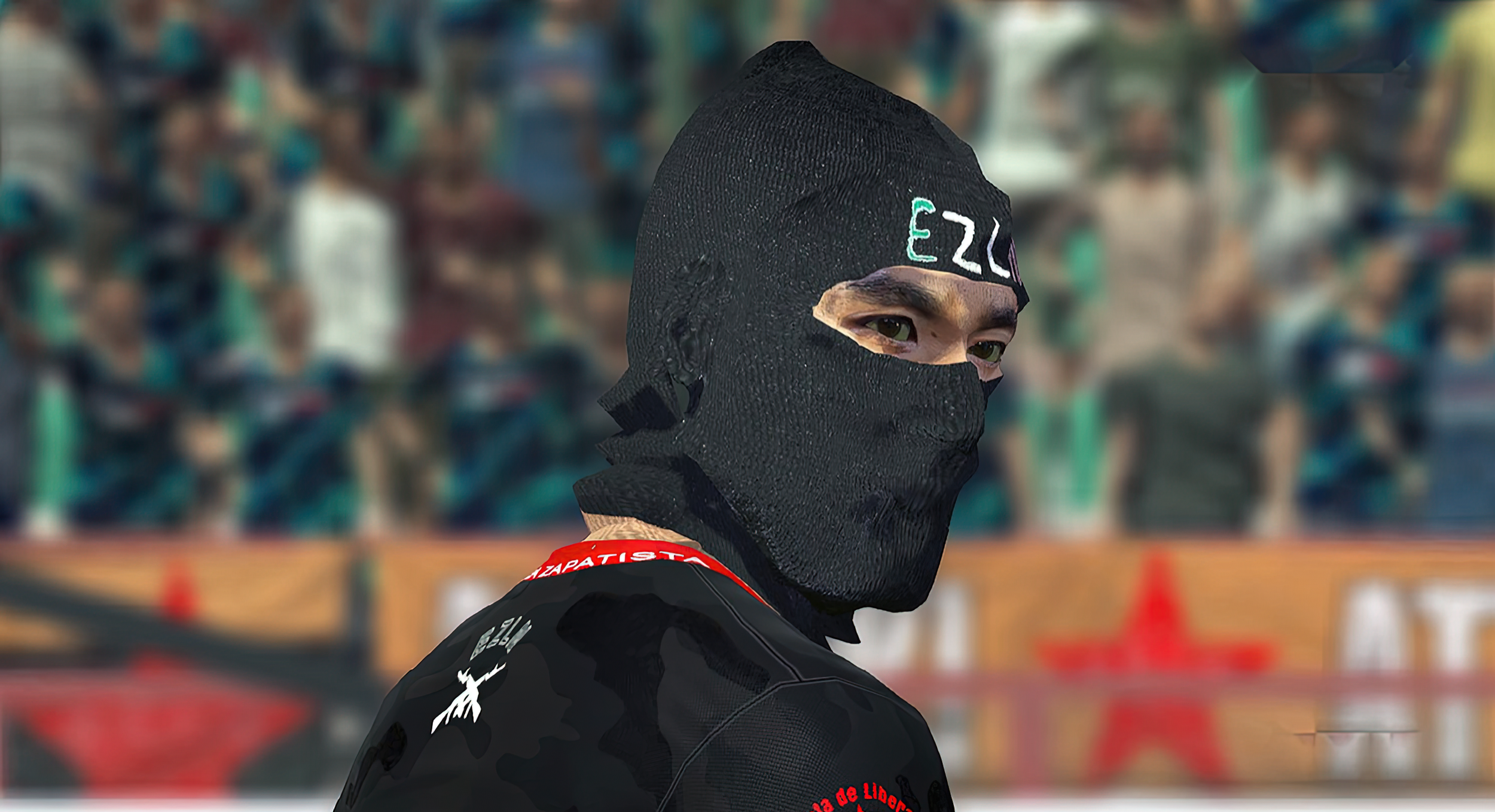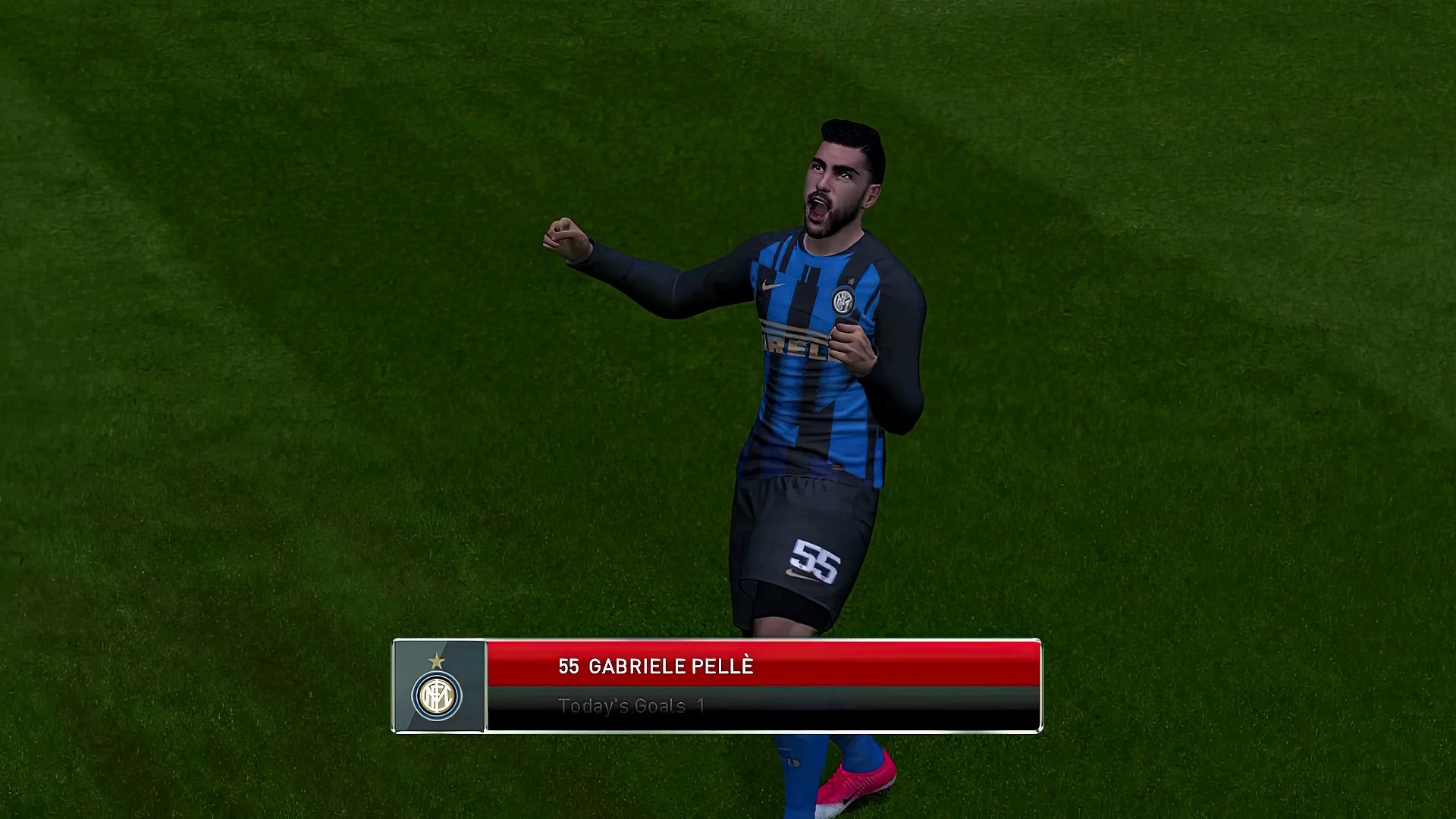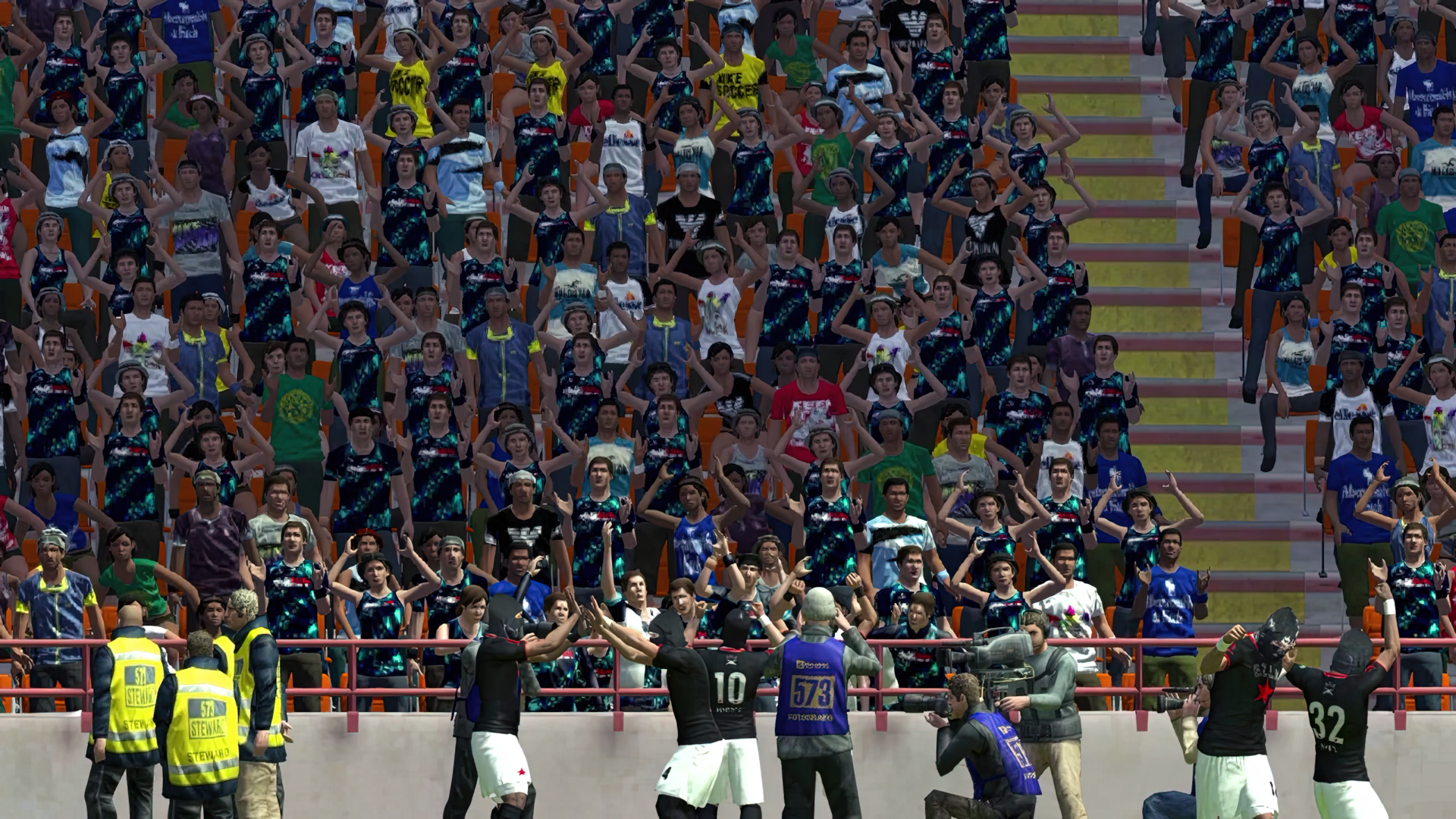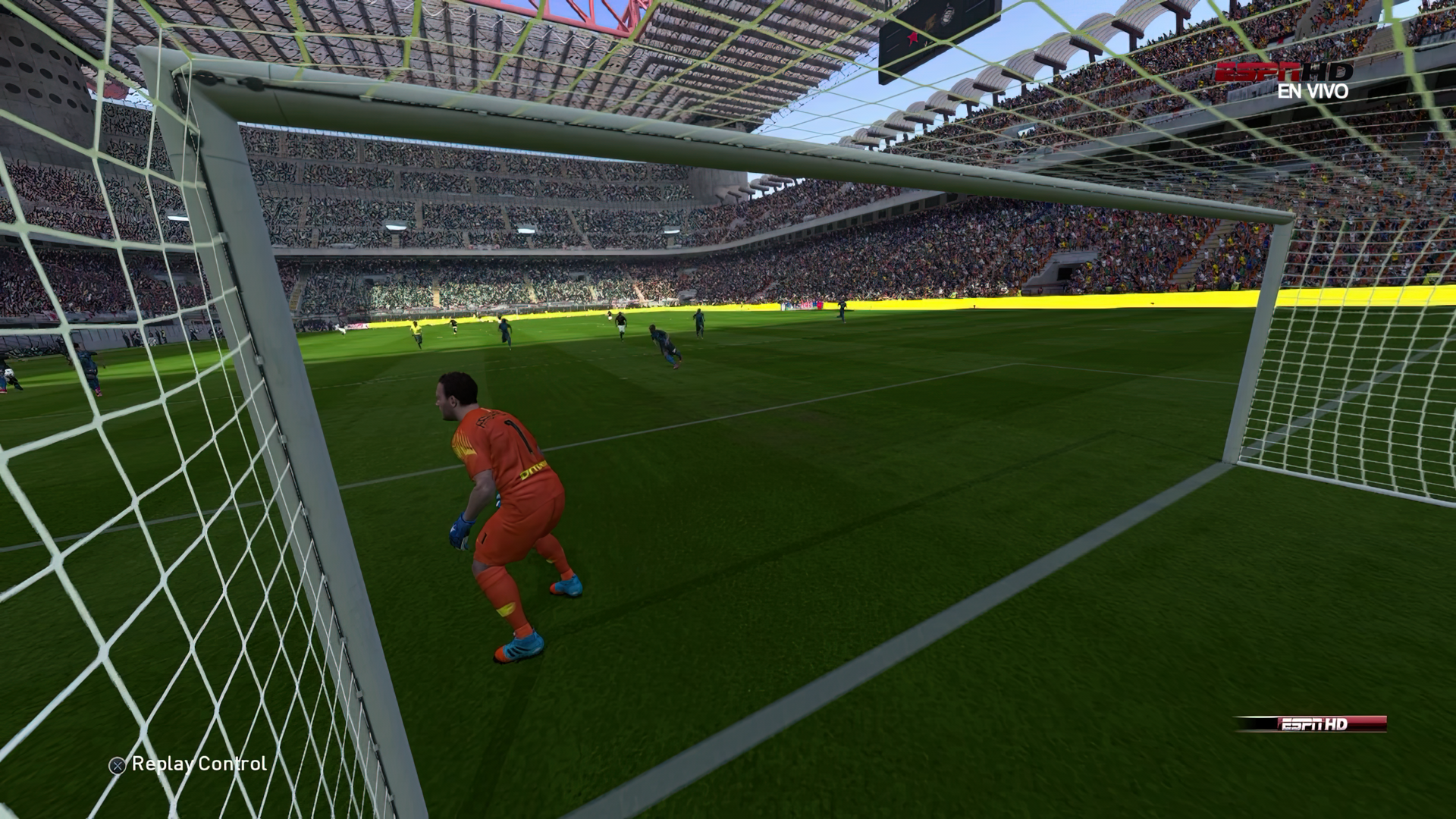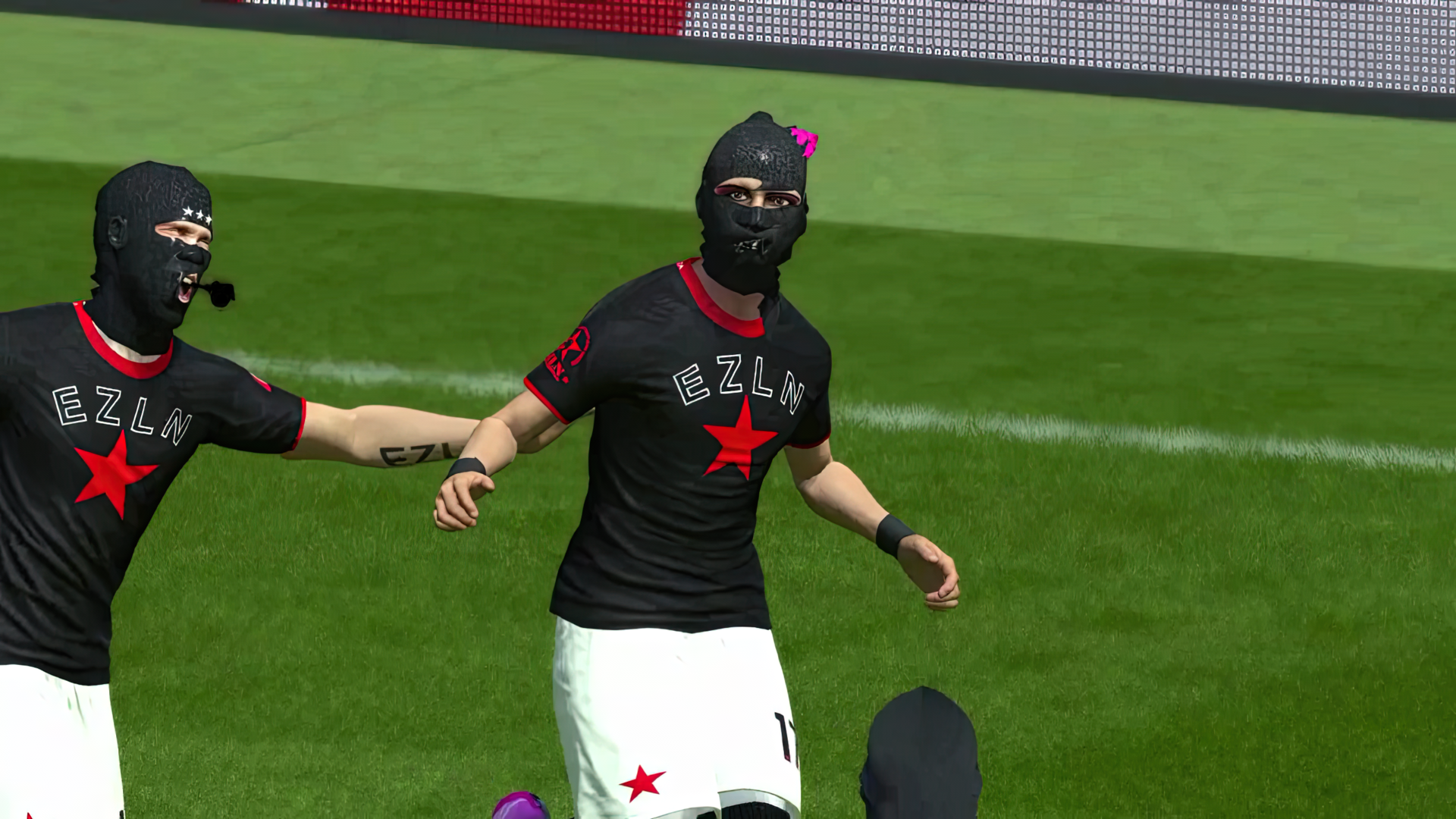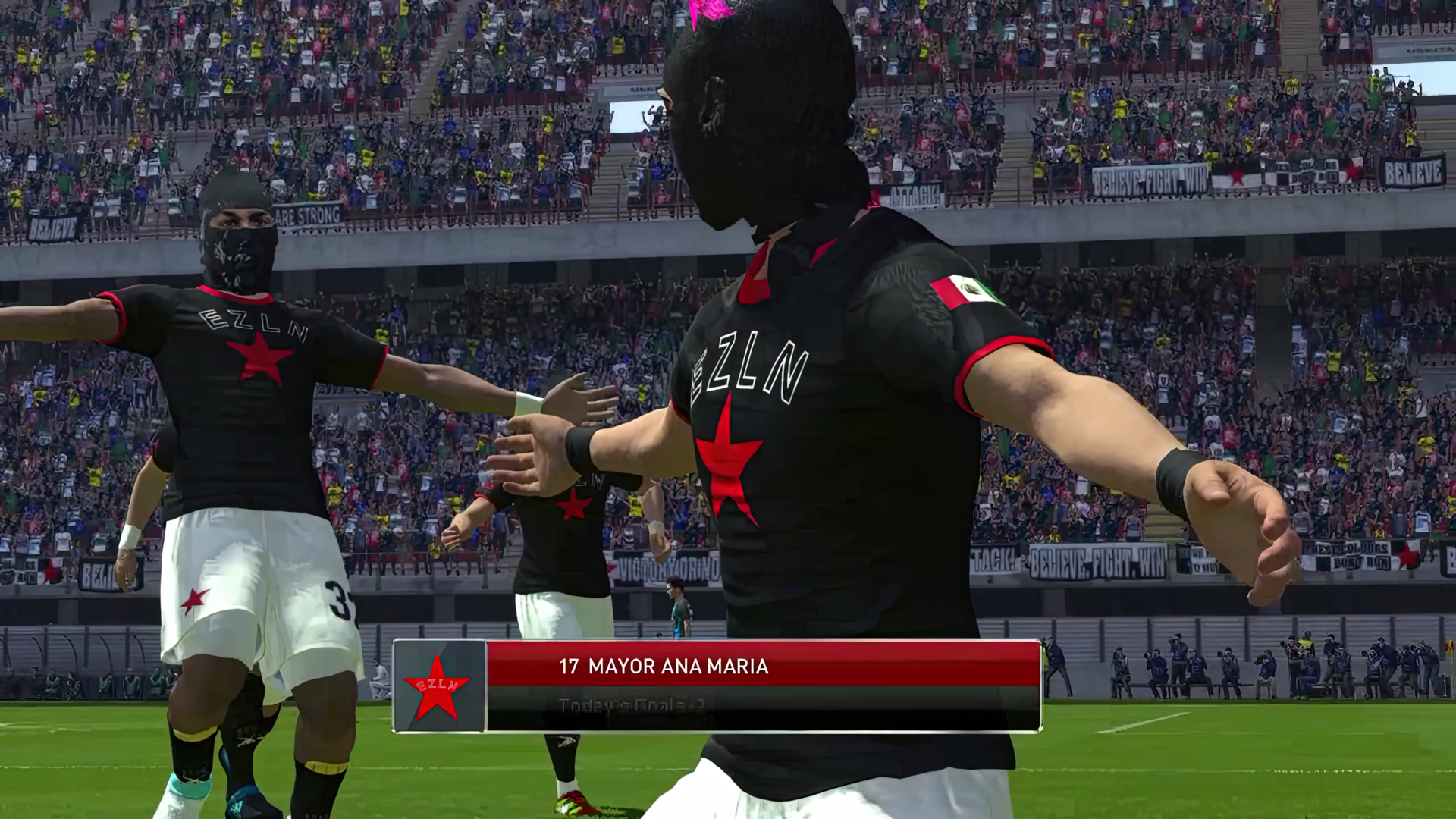Pro Revolution Soccer
Custom PC, modified game, two controllers, two custom-made gaming seats, sound system, projector, and vinyl screen structure, 2019 hereby presented as a gameplay video (1920 x 1080), color, sound, 21’ 23”, Colombia, 2019
Created by Juan Obando
Pro Revolution Soccer is an interactive installation that deftly reimagines the popular football simulation Pro Evolution Soccer (PES). Drawing inspiration from the profound bond between the Zapatista Army of National Liberation (EZLN) and the Italian soccer club Inter Milan, this artwork ingeniously introduces the EZLN as an enthralling new feature within the simulation. Evoking the enigmatic essence of a mythical football match, the work unfurls an intriguing narrative where EZLN daringly challenges the Italian team, forever suspended in the realm of imagination, in a stadium covered with such banners as NO ESTAMO SOLOS, RAMONA VIVE, TIERRA & LIBERTÀ, PARA TODO TODOS, LA LUCHA NUNCA TERMINA. Originally presented as an interactive installation based on a modified version of Konami’s soccer simulation, the artwork is presented on VRAL as a one channel gameplay video.
Juan Obando is an artist from Bogotá, Colombia, specializing in interventions within social systems. Through video performances, post-digital objects, and screen-based installations, Obando explores the collision of ideology and aesthetics, sparking the emergence of speculative new worlds. Obando’s work has garnered international recognition, with exhibitions held in Mexico, France, Colombia, Germany, and the United States. Notable solo shows include “Fake New” at General Expenses (Mexico City, México), “Summer Sets” in Faneuil Hall (Boston, MA, 2022), “DEMO” at Museo Espacio (Aguascalientes, MX, 2022), and “La Bodeguita de La Concordia” at Galería Santa Fé for the Luis Caballero National Art Prize (Bogotá, Colombia, 2021). Selected group exhibitions include First Place In The Table? (Trafo, Szczecin, Poland, 2022), Game Changers (MAAM, Boston, 2020), Video Sur (Palais de Tokyo, France, 2018), La Vuelta (Rencontres de la Photographie, Arles, France, 2017), and MDE15 (Medellín, Colombia, 2015). Obando was also awarded a Rhizome commission from The New Museum in 2012, a MassArt Foundation grant in 2017, and an Art Matters fellowship in 2019.
Matteo Bittanti: I am deeply intrigued by the creative process behind your remarkable modification of Konami’s popular video game. Could you share the origins and evolution of this project, shedding light on the inspiration that propelled its inception and subsequent development? I’m curious to learn about the technical hurdles encountered along the way and the strategies employed to overcome them. What is your relationship to modding as an artistic rather than merely technical practice? It seems clear that you are directly following the tradition of Anne-Marie Schleiner, Joan Leandre, and Brody Condon’s seminal Velvet Strike. Am I off track?
Juan Obando: I was spending some time in Mexico City as part of a residency at SOMA and struggling with another project that had me a little bit stuck. One night while drinking with friends, one of them mentioned the story of EZLN (Zapatista Army of National Liberation) and Inter, and I was incredibly amazed by it. The number of distinct connections implicated in this mythology: Inter, sponsored by Nike and Pirelli, almost coerced by their Argentinian star player to support an indigenous guerrilla in the mountains of Mexico, EZLN, and their own poetic narratives where soccer is used as a metaphor for the revolutionary struggle, a guerrilla lead by a phantasmagoric figure that dissolves under various pseudonyms… It’s so rich. The fact that this soccer match between EZLN and Inter never came to be was just too much. I immediately felt I had to create something to move this story forward.
I don’t have a particular history with modding or even gaming beyond having grown up in the height of the Nintendo craze of the mid to late Eighties. Still, my work is completely based on appropriation from the culture of screens and hacking as a conceptual practice. I see a rich field of artistic medium and support in mobile apps, computer interfaces, large screens, billboards, and projections.
The closest to modding I have been, and the direct inspiration to intervene Pro Evolution Soccer to stage the EZLN-Inter Match, is my friends growing up addicted to the early version of PES titled Winning Eleven. I was not too much into it. I don’t follow soccer and I was terrible at the video game. The pirate versions they used to buy came already equipped with local Colombian teams and players, even some stadiums as “parches” (patches). This was mind-blowing to me at the time. These Colombian parcheros, all self-taught, were modifying the game and then distributing it in the streets, making a whole generation of kids play with their local idols.
So in researching EZLN’s own history with soccer, it was so clear to me that PES parcheros had something very deep in common with a guerrilla such as EZLN whose objective is not to overthrow the Mexican government but to stage an autonomous zone within the Mexican state. EZLN represents an alternative to the historical failure of revolutions defined by a system’s takeover. Likewise, these hackers don’t want to destroy PES; they just want to redefine it with their favorite teams and insert their own imagination into the logic of the overall system. It seemed natural to stage the EZLN-Inter story as a hack in a global gaming environment influenced by parcheros. EZLN’s and parcheros’ relationships with operating systems are equally parasitic.
The major technical difficulty was finding a good parchero to work with. I had all the designs for menus, characters, uniforms, stadiums, and signs but needed someone with the “key”. Once in, it was actually fun and straightforward. You play by the system’s rules, but there is so much room in between… it’s just a perfect example of “almost infinitum”, the enormous distance between one number and the next — pure code.
I honestly didn’t know about the artists you mentioned. I will find out more about them. My closer references to modding in art come from Eva and Franco Mattes, Cory Arcangel, and Miltos Manetas.
Matteo Bittanti: How would you characterize your relationship with the medium of video games in general, and with sport simulations in particular? What draws you to digital games as a vehicle for creative expression and critical exploration? How can sports simulation function as a site for socio-political commentary?
Juan Obando: I guess my relationship with video games has always been very passive, mostly driven by curiosity. Like, I’ve never been into any particular game and only owned consoles as a kid. But I’m immensely captivated by the role of gaming in our world, the associated behaviors and aesthetics. I feel that there’s not a particular genre of games that is more apt as a site for art intervention than others. Talking about Miltos Manetas: he would put Mario to sleep for hours in Super Mario 64 or have Lara Croft in early versions of Tomb Raider be constantly punctured by shooting arrows. These, for me, were profound meditations on the physicality and emptiness of these characters — it wasn’t about the genre of those games but about the role these characters occupy within popular imagination, their cultural flexibility as containers of multiple ideologies and expectations at the same time.
Matteo Bittanti: The relationship between soccer and politics is intricate and multi-faceted, and yet it reveals a clear trajectory to a discerning eye. For instance, when examining the athletes themselves, we observe an evolution from left-leaning politics to a shift towards the far right. A comparative analysis of Brazilian players such as Sócrates Brasileiro Sampaio de Souza Vieira de Oliveira, popularly known as Doctor Socrates, in the 1980s, and Neymar da Silva Santos Júnior today illustrates this trend. While Doctor Socrates was associated with left-wing politics, Neymar openly supported Jair Bolsonaro, alongside the majority of his teammates. Furthermore, an examination of soccer supporters demonstrates a strong connection between hooliganism and the far right. Consider, for instance, S.S. Lazio Italian fans who overwhelmingly and overtly embrace fascist ideologies. This association reflects a concerning trend within certain fan communities, including digital gaming. In her seminal essayAnger, Fear, and Games: The Long Event of #GamerGate (2016), Torill Elvira Mortensen draws parallels between the members of the GamerGate (2014-2015) movement — a massive online harassment campaign against women, which eventually became associated with the so-called Alt-Right— and hooligans. In lieu of these observations, one might question why games, in their various forms, are particularly susceptible to being co-opted by the far right. Is it because they offer a platform for individuals with fringe or extremist views to gather and communicate, providing a sense of community and validation? Is the anonymity and detachment from real-world consequences that games often provide emboldening individuals to express and spread extremist ideologies without fear of immediate repercussions? Is the culprit the competitive and tribal nature of gaming communities which foster a sense of “us versus them” mentality, aligned with far-right ideologies that emphasize division and exclusion? As an artist working with game assets and playful metaphors, what is your take?
Juan Obando: This is a complicated question, but I appreciate this complexity nonetheless. Let’s see. First of all, I remain suspicious of the narrative around the dangers of the “far right” or “alt-right” or the many other versions of political boogiemen in the mythology of cultural warfare spawned by the last ten or so years of US domestic politics. I consider the expansion of this language beyond the US border as a form of cultural imperialism and internally, in the US, as a tool for the erasure of class politics — an adversarial dynamic deployed to the public in the form of memetic discourse that, for me, is the death of all imagination and a perfect obstacle for class solidarity.
As for the reality of conservative ideology associated with gamers and soccer fans, it is not a surprise to me. In their case, as in any other subcultures highly dependable on their relation to intense consumption of mass media, they have interiorized the dynamics of propaganda the most, to a point in which they might experience a profoundly spiritual and biological cognition of how indoctrination works, in them and others. They feel the system is operating but not working for most and realize their value in a progressive neoliberal economy doubles as niche consumers and adversaries. They’re outsiders and insiders simultaneously, and when this disenfranchising happens at such an intense level, any message that promises some kind of redemption or control can come sweeping in from ideologues, bodybuilders, diet peddlers, or pharmaceuticals.
Calling it a co-optation excludes us from realizing our own instrumentalization. By us, I mean “democratic liberals” in the Western world. Our ideological indoctrination goes deeper than the mere reactionary immaturity of gamers and soccer fans. We are convinced that our system will fix itself if we “play” it more intensively by including more identities within it and by dressing it up with the right colors. The violent and exploitative macro-structure sustaining the facade of a well-intentioned liberal democracy in the West is ever more invisible as we focus on its interface rather than on the system itself. Right vs Left discourse is how we reify the other as our moral opposite when we constantly advocate for policies and politicians that advance global warfare, corporate exploitation, cultural censorship, and devastating environmental practices.
What attracted me to EZLN was precisely its distance from the identitarian and divisive binary discourses of left and right. Their masked identity only is already an exercise in imaginative poetics of representation moving forward from these narratives. It proposes new communal bodies that resist complex forces, understanding that the “enemy” has many faces, and we constantly embody them. We are all included in their critique, and this inclusion is humbling and empowering because it allows us to recognize ourselves in others, many of whom we’ve previously been taught to antagonize.
Matteo Bittanti: You explicitly reference the notion of TAZ, an acronym of Temporary Autonomous Zone by Hakim Bey (aka Peter Lamborn Wilson) which refers to the possibility of individuals converging to construct an alternative social structure that defies the confines and dictates of dominant systems. The process entails challenging authority, hierarchy, and control, best exemplified by practices such as squatting, pirate radios, and protest camps. Mainstream video games, as potent vehicles of neoliberalism and ludic embodiments of Byung-Chul Han’s concept of psychopolitics — an all-encompassing ideology focused on the control of minds rather than bodies (as in Foucault’s notion of biopolitics) — appear to be an ideal terrain for subversion and hacking. However, Pro Revolution Soccer emerges as a relatively uncommon instance amidst an ocean of vernacular mods, which, rather than rejecting the game’s overarching message and values, merely tweak certain cosmetic aspects. How might you account for the scarcity of artistic/critical mods within this realm?
Juan Obando: Again, I’m not well-versed in gaming and mods, even in contemporary art practices, so I don’t feel entitled to give a definite answer. My thoughts on this are more specific toward what we consider the mainstream art world and the capacities of art in general. You can say something similar of the industry of contemporary art, even with its past historical proclivity to champion antagonism, subversion, and provocation. How come there’s so little disruption in it nowadays? I think that historical romanticization clouds the fact that art’s most substantial impact is profoundly personal and self-gratifying. For me, engaging in projects such as Pro Revolution Soccer is an exercise in learning, growing, and having fun. Yes, I have hopes of providing an active space for reflection on a piece like this, maybe even a short sense of communion between participants that could evoke some reframing of our modes of consumption, spectatorship, and enunciation. But I’m also aware of the limitations of this sort of work. As you mentioned, practices such as organized hacking and piracy, real political organization, or even imaginative guerrilla warfare such as EZLN, are way more effective in bringing systemic disruption without having to think of it as art or being framed by a specific media genre like gaming.
That scarcity of critical or artistic modding you mention could be attributed to the new forms of media consumption associated with the Internet and social media: the infinite scroll, the never-ending playlist, and binge-watching. There are few moments to feel bored now, to play a game for so long without any “updates” or “expansions” that you come to a point in which you are inspired to exert your creativity on it. Algorithmic consumption and creative passivity go hand in hand.
Matteo Bittanti: Here’s a corollary: although FIFA Soccer’s popularity in the football simulation arena is undisputed and an enormous modding community, the most interesting artistic mods usually feature Pro Evolution Soccer. Two recent examples come to mind: Gweni Llwyd and Owen Davies’s Becoming a Legend (2020) and The Cool Couple’s Emozioni Mondiali (2018). The former can be considered a commentary on masculinity, while the latter is a playful take on the practice of institutional critique. Since you are a practitioner, I wonder: Can this preference for artistic appropriations of Konami’s game be explained in solely technical terms? In other words, is PES more conducive to experimentation because of its specific affordances, or is there another reason? Another factor to keep in mind is that PES was produced by a Japanese company while FIFA Soccer is the quintessential “Made in the US” video game. Alongside Activision Blizzard, Electronic Arts is likely the most corporate expression of video gaming.
Juan Obando: From my only experience working with this media, PES offers the most flexible environment for intervention. It’s more open, and there’s already an extensive history of modding for it. Of course, now PES being the underdog, with FIFA taking most of the licenses away, it also sort of becomes the “game of the people,” adding to its lure.
Matteo Bittanti: I wholeheartedly agree. As an example, I recall a remarkable undertaking undertaken by the Italian artist Giovanni Fredi in the early 2010s. He captured the essence of young men from Kinshasa, Congo engrossed in Pro Evolution Soccer 2008. Fredi’s photographs showcase their unwavering devotion for the game. Throughout its existence, PES has consistently been regarded as an inclusive and egalitarian game. Speaking of the politics of gaming, in his seminal anthology of essays on algorithmic culture (2006), American scholar Alexander Galloway introduced the notion of countergaming to indicate the subversive potential of video games as a means to challenge dominant ideologies and power structures. Specifically, countergaming as a form of critical intervention within the realm of gaming encompasses various practices and strategies that seek to disrupt or subvert the norms and conventions prevalent in mainstream gaming culture. This approach often involves creating alternative game experiences that aim to challenge the dominant narratives, mechanics, and aesthetics found in commercial video games. It can also involve the modification or hacking of existing games to create new experiences that defy the original intentions of the game developers. Additionally, countergaming may manifest as in-game activism or protests, where players organize and engage in collective actions within the virtual space to raise awareness or advocate for social and political causes. Now, in its deft manipulation of code’s inherent malleability, Pro Revolution Soccer emerges as an eloquent locus for subverting dominant political structures from within. As such, it does appear to be an example of countergaming. Traditionally inhabited by the commodified avatars of sports icons endorsing consumer products and de facto operating as “brand ambassadors”, in your installation the virtual soccer field undergoes a radical transfiguration, welcoming an unexpected presence, the members of the Zapatista Army of National Liberation (EZLN). Remarkably, despite this intervention, the underlying game mechanics and rules remain unaltered. This invites a critical question — one that challenges the potential superficiality of this subversive act: albeit visually striking, is this kind of modding just an empty signifier, a simulacrum, thus skin deep — no pun intended? Somebody said that the revolution won’t be televised. But what happens when the revolution is just simulated? Can countergaming produce concrete social change or does it remain confined in the realm of the imaginary?
Juan Obando: A fascinating question, and thanks for the link to Galloway, I am very curious about his work now. For me, the power of art is precisely its resistance to ideological instrumentalization. To assign the responsibility of social engineering to a work of art is to diminish its imaginative and evocative power.
If we understand how simulacra works in our society — for example, in the form of democracy — we can appreciate the potential power of the poetics involved in art, countergaming, or the playful semantics of EZLN. Simulation is not exclusive to art, gaming, or digital world-building. We actively participate in one, if not many, simulations every day. Every few years, societies worldwide take part in electoral politics as a testament to “shared reality,” but the underlying mechanics of voting —from financing, campaigning, registration, and accounting— are completely corrupted and malleable. I recently developed a piece exploring this subject. In the United States, publicly-advertised companies openly provide large crowds on demand for political purposes —paid actors for massive political warfare. It is completely normalized. Many of these companies are behind the last few years’ largest “organic” social movements, yet these are mostly paid performances —simulations. The name of this practice is “Astroturfing”, named after the major artificial grass supplier in the US, and in opposition to “grassroots activism”. These simulations are extremely powerful. They achieve massive consensus, seeding widespread unrest and division, and advance the agendas of the most exploitative industries in the history of humanity.
The difference between art and counter-gaming is that in those cases, the simulation is explicit as it is framed by a context in which you are made aware of your role in it. You are made aware that you are a player and that you are also being played, and that level of consciousness is enough for me to be interested in my work existing in that realm. It’s not always easy or comfortable to be engaged in the trafficking of signs, but it is one of the few moments in which I can collect my own power and agency, take chunks out of the massive simulation that is our modern world and create a situation of my own.
Matteo Bittanti: I appreciate the diversity within the ELZN team, consisting of both men and women. In the video we are showcasing on VRAL, Major Ana María takes center stage, and what caught my attention is the unique combination of a female-looking face behind the balaclava and a male-looking body for the modded character. This intriguing blend raises questions about the avatar's representation as a truly post-gender entity. I'm curious to know whether this hybridity was a deliberate choice on your part or if it was due to limitations within the modding editor regarding the availability of male-looking bodies.
Juan Obando: With Pro Revolution Soccer, I wanted to highlight the names (primarily pseudonyms) of some of the combatants present in the 1994 uprising in San Cristobal de Las Casas. These compose the majority of the EZLN team in this work. I also wanted to be faithful to the feminist nature of EZLN, and how women play a central role in developing this community. Ramona, Susana, and Ana María are iconic in the history of the Zapatista movement, and adding them to the team required messing with the internal architecture of the game and the 3D space allocated for bodies within its environment. The internal sculpting of bodies in PES is very limited, and these limitations result in what you see today. They could signal traditional post-gender embodiments in Mexico, such as the Muxes, but, again, these don't respond or are a result whatsoever of our current views on gender identity. Muxes have a long, complex history, but that is beyond what I intended to do with this work. For me, it was about recognizing the integrity of EZLN and how women are central to it.
Matteo Bittanti: I imagine that during the original presentation of Pro Revolution Soccer at Espacio Odeón in Bogotá, Colombia in 2019, the artwork provoked diverse reactions from the viewers. As the installation features two controllers and two custom-made gaming seats, it clearly encourages viewers’ active participation. Could you describe the initial reception of Pro Revolution Soccer within the context of an art gallery? How did they respond to the artwork’s concept and presentation? Were there any immediate reactions that stood out to you? Were there any notable discussions or conversations that emerged as a result of the artwork? Did you notice any contrasting perspectives or unexpected interpretations that caught your attention?
Juan Obando: First of all, it was amazing to see PES’s incredible connection with people from my generation; it clicked immediately. Secondly, I was also quite taken by how memory-holed EZLN is from people’s imagination. Like, in the 1990s and early 2000s you would see EZLN images all over. It basically became the official image of the band Rage Against The Machine. Back then, many of us knew about the Zapatistas and their cause in Chiapas. Nowadays, most people don’t even know who they are or if they’re active. What the piece did is that it ignited a curiosity about the current state of EZLN and Chiapas through a fascination generated by EZLN’s history with soccer. The biggest questions were, “How come we didn’t know about this?”, “How come EZLN still exists and survives in the world of today?”
In the two instances where the installation was featured (In Epacio Odeón in Bogotá and in MAAM Boston), the major conversation centered around some of your previous questions. The discussions focused on the power of intervention on major operating systems and the historical failure of revolutions. What’s difficult for most of us to realize is that the narrative of EZLN involves a parallel reality that runs along the timeline of neoliberalism and global capitalism, but it doesn’t respond to their logic, our logic. As victims of our spectacular times, as media consumers, we feel disappointed by the complexity of EZLN’s story. There are no legendary martyrs, as with Che Guevara; no cameos in House of Cards or revolutionary NFTs, as with Pussy Riot. What we have in Chiapas is a sustainable affair with the hope of possibility, a de-linking with market logic, and constant reconstruction of people’s relationships with the land, with others, and with themselves.
Pro Revolution Soccer
Custom PC, modified game, two controllers, two custom-made gaming seats, sound system, projector, and vinyl screen structure, 2019
hereby presented as a gameplay video (1920x1080), color, sound, 21’ 23”, Colombia, 2019
Created by Juan Obando, 2019
Courtesy of Juan Obando, 2023
Made with Pro Evolution Soccer 2019 (PES Productions, Konami, 2018)



